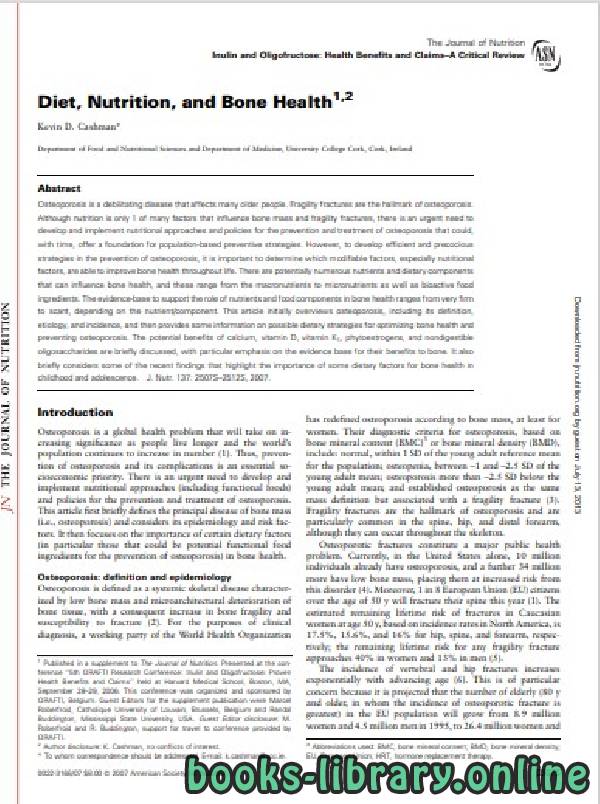📘 قراءة كتاب Diet, Nutrition, and Bone Health1,2 أونلاين


النظام الغذائي والتغذية وصحة العظام 1،2
ملخص القسم التالي
هشاشة العظام مرض منهك يصيب العديد من كبار السن. كسور الهشاشة هي السمة المميزة لهشاشة العظام. على الرغم من أن التغذية هي عامل واحد فقط من العديد من العوامل التي تؤثر على كتلة العظام وكسور الهشاشة ، إلا أن هناك حاجة ملحة لتطوير وتنفيذ مناهج وسياسات غذائية للوقاية من هشاشة العظام وعلاجها والتي يمكن أن توفر ، مع مرور الوقت ، أساسًا للوقاية السكانية الاستراتيجيات. ومع ذلك ، لتطوير استراتيجيات فعالة ومبكرة للوقاية من هشاشة العظام ، من المهم تحديد العوامل القابلة للتعديل ، وخاصة العوامل الغذائية ، القادرة على تحسين صحة العظام طوال الحياة. من المحتمل أن يكون هناك العديد من العناصر الغذائية والمكونات الغذائية التي يمكن أن تؤثر على صحة العظام ، وتتراوح هذه العناصر من المغذيات الكبيرة إلى المغذيات الدقيقة وكذلك المكونات الغذائية النشطة بيولوجيًا. تتراوح قاعدة الأدلة لدعم دور العناصر الغذائية ومكونات الغذاء في صحة العظام من شديد الصلابة إلى ضئيل ، اعتمادًا على العنصر الغذائي / المكون. تتناول هذه المقالة في البداية نظرة عامة على هشاشة العظام ، بما في ذلك تعريفها ومسبباتها ومدى حدوثها ، ثم تقدم بعض المعلومات حول الاستراتيجيات الغذائية الممكنة لتحسين صحة العظام والوقاية من هشاشة العظام. تمت مناقشة الفوائد المحتملة للكالسيوم وفيتامين د وفيتامين ك 1 واستروجين نباتي والسكريات قليلة الهضم غير القابلة للهضم بإيجاز ، مع التركيز بشكل خاص على قاعدة الأدلة لفوائدها للعظام. كما تتناول بإيجاز بعض النتائج الحديثة التي تسلط الضوء على أهمية بعض العوامل الغذائية لصحة العظام في الطفولة والمراهقة. حسب المغذيات / المكون. تتناول هذه المقالة في البداية نظرة عامة على هشاشة العظام ، بما في ذلك تعريفها ومسبباتها ومدى حدوثها ، ثم تقدم بعض المعلومات حول الاستراتيجيات الغذائية الممكنة لتحسين صحة العظام والوقاية من هشاشة العظام. تمت مناقشة الفوائد المحتملة للكالسيوم وفيتامين د وفيتامين ك 1 واستروجين نباتي والسكريات قليلة الهضم غير القابلة للهضم بإيجاز ، مع التركيز بشكل خاص على قاعدة الأدلة لفوائدها للعظام. كما تتناول بإيجاز بعض النتائج الحديثة التي تسلط الضوء على أهمية بعض العوامل الغذائية لصحة العظام في الطفولة والمراهقة. حسب المغذيات / المكون. تتناول هذه المقالة في البداية نظرة عامة على هشاشة العظام ، بما في ذلك تعريفها ومسبباتها ومدى حدوثها ، ثم تقدم بعض المعلومات حول الاستراتيجيات الغذائية الممكنة لتحسين صحة العظام والوقاية من هشاشة العظام. تمت مناقشة الفوائد المحتملة للكالسيوم وفيتامين د وفيتامين ك 1 واستروجين نباتي والسكريات قليلة الهضم غير القابلة للهضم بإيجاز ، مع التركيز بشكل خاص على قاعدة الأدلة لفوائدها للعظام. كما تتناول بإيجاز بعض النتائج الحديثة التي تسلط الضوء على أهمية بعض العوامل الغذائية لصحة العظام في الطفولة والمراهقة. ثم يقدم بعض المعلومات عن الاستراتيجيات الغذائية الممكنة لتحسين صحة العظام والوقاية من هشاشة العظام. تمت مناقشة الفوائد المحتملة للكالسيوم وفيتامين د وفيتامين ك 1 واستروجين نباتي والسكريات قليلة الهضم غير القابلة للهضم بإيجاز ، مع التركيز بشكل خاص على قاعدة الأدلة لفوائدها للعظام. كما تتناول بإيجاز بعض النتائج الحديثة التي تسلط الضوء على أهمية بعض العوامل الغذائية لصحة العظام في الطفولة والمراهقة. ثم يقدم بعض المعلومات عن الاستراتيجيات الغذائية الممكنة لتحسين صحة العظام والوقاية من هشاشة العظام. تمت مناقشة الفوائد المحتملة للكالسيوم وفيتامين د وفيتامين ك 1 واستروجين نباتي والسكريات قليلة الهضم غير القابلة للهضم بإيجاز ، مع التركيز بشكل خاص على قاعدة الأدلة لفوائدها للعظام. كما تتناول بإيجاز بعض النتائج الحديثة التي تسلط الضوء على أهمية بعض العوامل الغذائية لصحة العظام في الطفولة والمراهقة.
Previous Section
Next Section
Introduction
Osteoporosis is a global health problem that will take on increasing significance as people live longer and the world's population continues to increase in number (1). Thus, prevention of osteoporosis and its complications is an essential socioeconomic priority. There is an urgent need to develop and implement nutritional approaches (including functional foods) and policies for the prevention and treatment of osteoporosis. This article first briefly defines the principal disease of bone mass (i.e., osteoporosis) and considers its epidemiology and risk factors. It then focuses on the importance of certain dietary factors (in particular those that could be potential functional food ingredients for the prevention of osteoporosis) in bone health.
Osteoporosis: definition and epidemiology
Osteoporosis is defined as a systemic skeletal disease characterized by low bone mass and microarchitectural deterioration of bone tissue, with a consequent increase in bone fragility and susceptibility to fracture (2). For the purposes of clinical diagnosis, a working party of the World Health Organization has redefined osteoporosis according to bone mass, at least for women. Their diagnostic criteria for osteoporosis, based on bone mineral content (BMC)3 or bone mineral density (BMD), include: normal, within 1 SD of the young adult reference mean for the population; osteopenia, between −1 and −2.5 SD of the young adult mean; osteoporosis more than −2.5 SD below the young adult mean; and established osteoporosis as the same mass definition but associated with a fragility fracture (3). Fragility fractures are the hallmark of osteoporosis and are particularly common in the spine, hip, and distal forearm, although they can occur throughout the skeleton.
Osteoporotic fractures constitute a major public health problem. Currently, in the United States alone, 10 million individuals already have osteoporosis, and a further 34 million more have low bone mass, placing them at increased risk from this disorder (4). Moreover, 1 in 8 European Union (EU) citizens over the age of 50 y will fracture their spine this year (1). The estimated remaining lifetime risk of fractures in Caucasian women at age 50 y, based on incidence rates in North America, is 17.5%, 15.6%, and 16% for hip, spine, and forearm, respectively; the remaining lifetime risk for any fragility fracture approaches 40% in women and 13% in men (5).
The incidence of vertebral and hip fractures increases exponentially with advancing age (6). This is of particular concern because it is projected that the number of elderly (80 y and older, in whom the incidence of osteoporotic fracture is greatest) in the EU population will grow from 8.9 million women and 4.5 million men in 1995, to 26.4 million women and 17.4 million men in 2050 (1). Similar demographic changes have been forecast for the U.S. population (7). Because of the increase in incidence rates of osteoporotic fractures with age, these demographic changes and increasing life expectancy will have a huge impact on the number of fractures that can be expected to occur. For example, the number of hip fractures occurring each year in the EU alone is estimated to rise from current figures of 414,000 to 972,000 by 2050, representing an increase of 135% (1). Hip fracture patients have an overall mortality of 15–30% (8), the majority of excess deaths occurring within the first 6 mo after the fracture.
From an economic perspective, the expenses of hospital care and rehabilitation associated with osteoporotic fractures are a considerable fiscal drain for the health care system, exceeding those of other highly prevalent pathologies of the elderly, such as myocardial infarction (9). Osteoporosis costs national treasuries over €3500 million annually in hospital health care alone (1).
Risk factors for osteoporosis
Low bone mineral mass is the main factor underlying osteoporotic fracture (10). Bone mass in later life depends on the peak bone mass achieved during growth and the rate of subsequent age-related bone loss. Development of maximal bone mass during growth and reduction of loss of bone later in life are the 2 main strategies of preventing osteoporosis (11). Consequently, any factor that influences the development of peak bone mass or the loss of bone in middle-age will affect later fracture risk. Several factors are thought to influence bone mass. These can be broadly grouped into factors that cannot be modified, such as gender, age, body (frame) size, genetics and ethnicity, and those factors that can be modified, such as hormonal status (especially sex and calciotropic hormone status), lifestyle factors including physical activity levels, smoking and alcohol consumption patterns, and diet (including functional foods). The interaction of these genetic, hormonal, environmental and nutritional factors influences both the development of bone to peak bone mass at maturity and its subsequent loss. The remainder of this article will focus on a selected number of dietary components/nutrients that may influence bone health.
Diet, nutrition and bone health
Many of the nutrients and food components we consume as part of a Westernized diet can potentially have a positive or negative impact on bone health (see Table 1). They may influence bone by various mechanisms, including alteration of bone structure, the rate of bone metabolism, the endocrine and/or paracrine system, and homeostasis of calcium and possibly of other bone-active mineral elements (12). These dietary factors range from inorganic minerals (e.g., calcium, magnesium, phosphorus, sodium, potassium, and various trace elements) and vitamins (vitamins A, D, E, K, C, and certain B vitamins), to macronutrients, such as protein and fatty acids. In addition, the relative proportions of these dietary factors derived from different types of diets (vegetarian vs. omnivorous) may also affect bone health and thus osteoporosis risk. Furthermore, in recent years a number of bioactive food components have been proposed as being beneficial for bone health. A review of all of these dietary factors is beyond the scope of the present article
حجم الكتاب عند التحميل : 664.1 كيلوبايت .
نوع الكتاب : pdf.
عداد القراءة:
اذا اعجبك الكتاب فضلاً اضغط على أعجبني و يمكنك تحميله من هنا:

شكرًا لمساهمتكم
شكراً لمساهمتكم معنا في الإرتقاء بمستوى المكتبة ، يمكنكم االتبليغ عن اخطاء او سوء اختيار للكتب وتصنيفها ومحتواها ، أو كتاب يُمنع نشره ، او محمي بحقوق طبع ونشر ، فضلاً قم بالتبليغ عن الكتاب المُخالف:
 قبل تحميل الكتاب ..
قبل تحميل الكتاب ..
يجب ان يتوفر لديكم برنامج تشغيل وقراءة ملفات pdf
يمكن تحميلة من هنا 'http://get.adobe.com/reader/'


 منصّة المكتبة
منصّة المكتبة